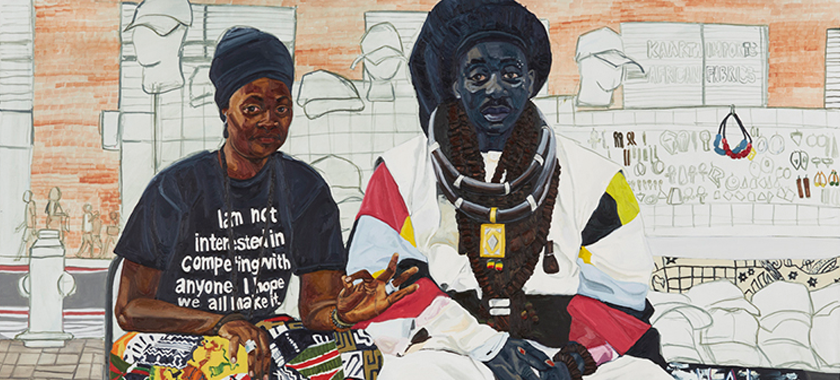Business of Art | The Artist’s Creed: 10 Guiding Principles for Your Arts Career
Make your arts career work for you with this empowering advice from artists.
There is no one way to be an artist. Artists use different media, explore a vast range of ideas, and face differing barriers and obstacles. Yet over the years we’ve observed that many artists have one thing in common: tenacity. Below, we’ve distilled advice from people we admire. These intentions and action steps can help you protect and strengthen yourself, as a member of a community, an individual who must survive in the world, and as a creator.
“Find the practice that works for you, and never apologize for it.” – Walidah Imarisha
You’ve most likely read an article, or many, about the routines that notable artists swear by as requirements for productivity. While content like this can be inspiring, it can also be discouraging and alienating. What if you’re not a morning person? What if you you can’t afford to create everyday because you’re juggling multiple jobs to pay the bills?
In the words of educator and writer Walidah Imarisha, writing or creating every day “works for some, but if it doesn’t, especially because you’re struggling to survive, it doesn’t mean you aren’t a writer” or artist. You are the only one who can set the best, and most feasible, rhythm and schedule for yourself.
Try: If fitting in large chunks of time for your art feels unattainable right now, set aside a few minutes on a regular basis to explore. This could be every night before you go to bed, on your morning commute, or during a break at work. Write down impressions of your environment, do a brief sketch, or think about ideas you’d like to explore in future work. You’ll find these few minutes will add up.
Or, if you’re ready and able to carve out more time aggressively but find yourself pulled in opposite directions by various priorities and responsibilities, set aside realistic chunks of time in your calendar to create. If your calendar is digital, set up reminder alerts. Treat this time as you would a work obligation.
Build yourself up.
Become your own best supporter. Writer Esmé Weijun Wang takes a documented approach. “My own self-belief has to be nurtured. I have a file of Kind Words that people have said or written to me…which I sometimes refer to.”
Try: Create your own repository of kind words. This could be a document you add to, or you could try a more tactile approach and list compliments on your wall or create text-based art with them.
Do the thing.
Creative block will manifest for every artist, but it is different for every artist. Perhaps, to counter it, you need rest, or a break, or to let yourself focus on another project. Ultimately, though, it can be helpful to “do the thing,” in the words of author Pam Stucky. Wendy Perron (Fellow in Choreography ’85) recommends doing the thing “even if at that (blocked) point, it feels really stupid and pointless. At least then you’ll have something to look at or fix or edit.”
It’s OK to ask for help.
You don’t have to do it alone. If you’re struggling in some way, it’s very likely there is someone or something that can help. That’s why NYFA offers the NYFA Source Hotline, a free referral hotline that you can call at (800) 232-2789, from Monday – Friday, 3:00 PM – 5:00 PM EST, or email at [email protected].
If you’re experiencing financial duress because of an emergency, you may be the perfect candidate for an emergency grant.
Try: Reach out. Your local arts council or arts organization likely has the exact resources you need. Need a writer’s community or workshop? They may be able to connect you. Is your studio space lease ending with no alternative in sight? Organizations like chashama and many others offer free and affordable residencies. And remember, your peer network—either online or in-person— is one of your best resources available to you. Your fellow creators may be able to provide you with feedback, spread the word about your events, and help you make connections. Just be sure to offer help in return to ensure a fair and equitable partnership.
“Watch your pals.” – Hanif Abdurraqib
It can be a challenge to find the perfect outlets for your work once you’re ready to share it with the world. Here’s a simple starting point from poet and essayist Hanif Abdurraqib: “All of my dream publications are the places I can be published next to the work of my friends and heroes.”
Try: Create a list of 10 favorite artists in your discipline with whom you feel an affinity in style or subject matter. These could be artists in your circle, online or in-person, or others you admire from afar. Where are they published? Which galleries exhibit their work? At which festivals have they performed? Then, research any relevant deadlines or eligibility guidelines and set reminders for deadlines and the steps you need to take along the way to be ready to submit.
Court rejection.
Don’t let the “no’s” you receive define you. Rejection is inevitable. Poet Lauren Whitehead speaks of “courting rejection.” Lean into the “no’s” you receive because that means you’re putting your work out there. Celebrate your rejections. Some even recommend aiming for 100 rejections per year, because that increases your odds of being accepted.
You can be financially stable.
Being an artist can be a financial challenge, whether you’re trying to finance a full-time artistic practice, pay student loans for your creative education, or afford studio space. But let’s throw out the stereotype of the starving artist. It is possible to survive, and even thrive, financially as an artist or creative, and there are many ways to reach this goal. Caitlin Pearce, Executive Director of the Freelancers Union, offers one strategy for independent contractors: “For many freelancers, stability comes with diversifying their income portfolio… [and with] finding diverse ways to monetize their skills and expertise.”
Try: Artists and creatives in all fields are often at a loss on how to price their work or services. Artist fees and hourly rates should be realistic in order to be competitive. But begin with the income you need, and want, to earn as your starting point, and prioritize this number. Your target annual income can help you find a sustainable hourly rate. Try using the formula provided by Andrew Simonet in Making Your Life as an Artist (free for download with newsletter sign-up).
Another principle to live by: when you’re creating a project budget, remember to pay yourself for your time.
Know your rights.
Here’s a staggering statistic from the National Endowment for the Arts: “American artists are highly entrepreneurial; they are 3.5 times more likely than the U.S. workforce to be self-employed.” This means that artists and creatives can find themselves without the protections of a standard workplace, shouldering more risk and liability.
There are steps you can take to protect yourself. Work with a contract so that expectations are clear. This is crucial for larger projects and highly recommended for smaller projects. The Freelancers Union offers contract templates that are compliant with New York City’s Freelance Isn’t Free Act, which protects the right to timely and full payment.
Another consideration for independent contractors: try to avoid work for hire contracts, in which the party that commissions the work or the employer owns the rights to the work. Poet, educator, and performer Denice Frohman cautions: “Don’t give your rights away.”
Try: There are a range of contract templates online or you may want to ask peers to share their template with you. Photographer Reggie Cunningham reworks templates that large companies and clients have sent to him. Whatever your method, resolve to find the format that works for you, so that it’s ready to go before your next opportunity presents itself.
Protect your work, invest in your future.
Your work and your well-being are precious resources; luckily, protecting yourself is well within your power. Every small step you take adds up to readiness in the face of disaster, as well as readiness for exciting opportunities in your arts career.
It’s important to document your work and related materials. “Archives help capture what can easily be lost.” says Eric Colleary, Cline Curator of Theatre & Performing Arts at the Harry Ransom Center. For many artists, “documenting their work for posterity almost becomes an artwork itself“ and is a highly individual process. Apply the same care and creativity in preserving your work as you do in producing it.
Try: Every tiny step is helpful. Here’s an example: look around your studio or living or storage space. Are there important materials in a basement or attic that could flood or experience extreme temperature shifts? Move them to a safer spot. Or, research opportunities to preserve your assets. CERF+ offers mini grants for craft artists called Get Ready Grants to help artists safeguard their studios and their careers.
Ready to start archiving? Here are a few resources that can guide you through the archival process: a guide from the Joan Mitchell Foundation for visual artists; Dance Heritage Coalitions Artist’s Legacy Toolkit; and resources on preserving electronic and time-based works from the American Institute for Conservation of Historic and Artistic Works. Thinking about your legacy early on will also help you get your work out into the world in the present.
The world needs your perspective.
Artists are all too familiar with imposter syndrome, as people who make their own rules and create something out of nothing. This leaves room for doubt. Over time, you’ll find your own ways to counter this feeling, but try starting with affirmations that help you fake it ‘till you make it. Writer Brandon Taylor says: “I try to remind myself that my work is worthy. Sometimes I literally say that in the shower until I believe it. ‘Your work is worthy, your work is worthy, your work is worthy.’ I try to take it very seriously. So that even if I suck that day, I still try.”
On top of everyday imposter syndrome, many artists receive messaging, subtle or otherwise, that their work or experiences are less valued than others. Deanna Fei (Fellow in Fiction ’06) on writing about her experiences as a parent: “We assume the family or domestic sphere is less worthy as fodder for art. But race, class, power are in every class and playground.” Disregard that prejudice and create “what inspires you. Start with the tiny and specific. Then go wide and big.”
– Mirielle Clifford, Program Officer, Online Resources
This article draws inspiration from #ArtistHotline, an initiative dedicated to creating an ongoing online conversation around the professional side of artistic practice. Our goal is to help artists discover the resources needed, online and off, to develop sustainable careers.
Have an arts career question? You can contact NYFA staff directly via the NYFA Source Hotline at (800) 232-2789, from Monday – Friday, 3:00 – 5:00 PM EST or email [email protected].
This initiative is supported by the Emily Hall Tremaine Foundation.





